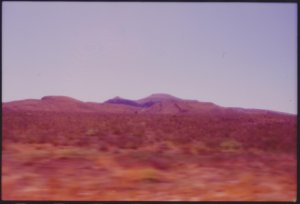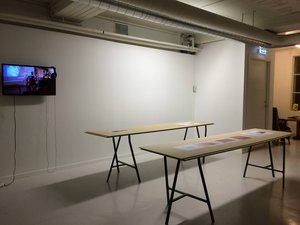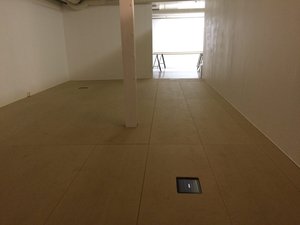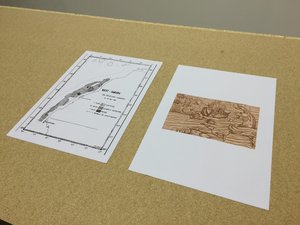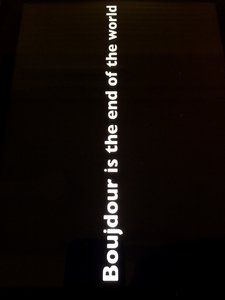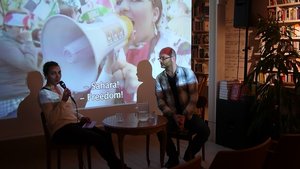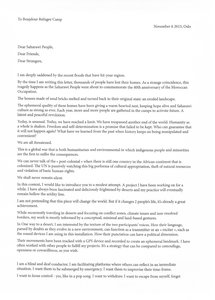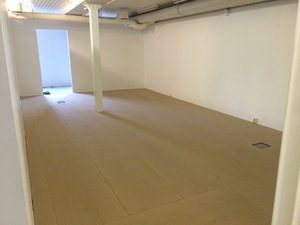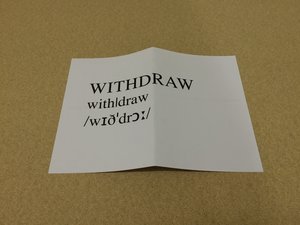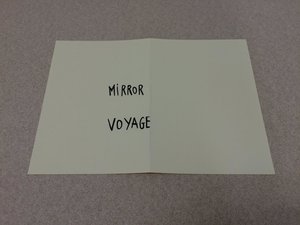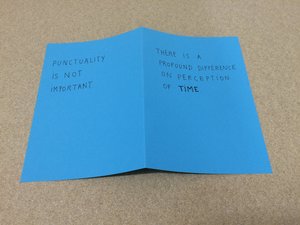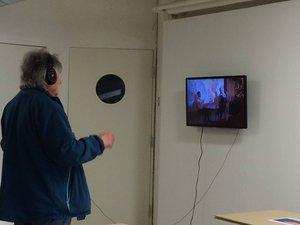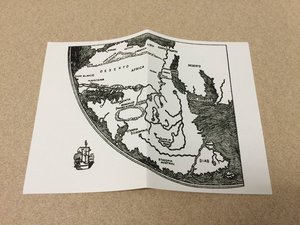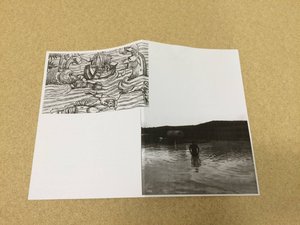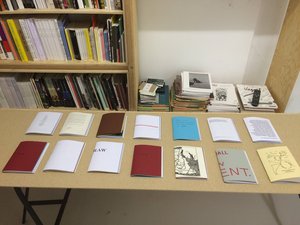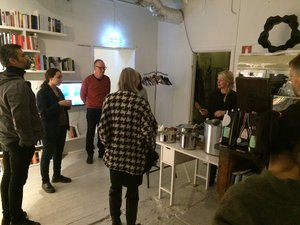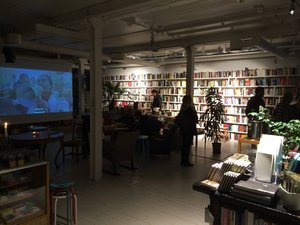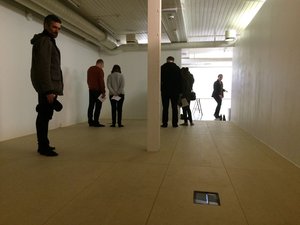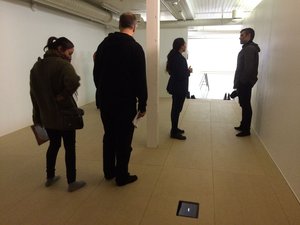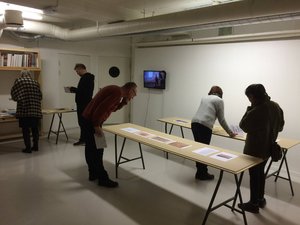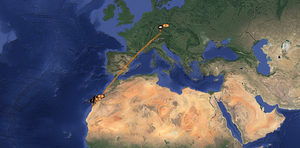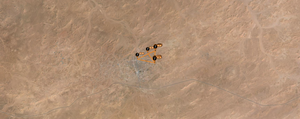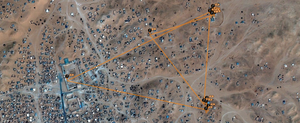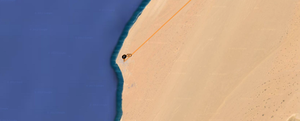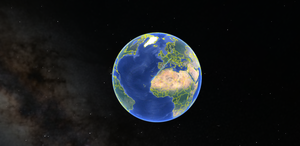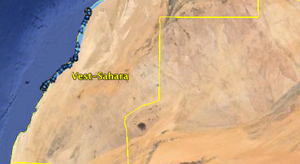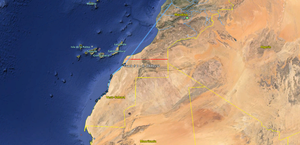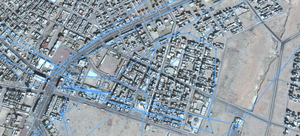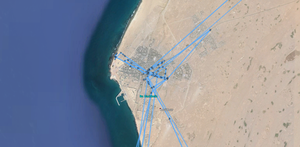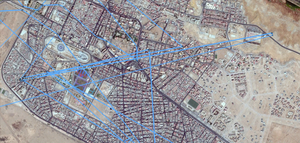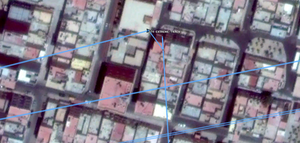One way to a desert
2021
Duo exhibition, Hordaland Kunstsenter, Bergen, curated by Amber Ablett. More information coming soon.
2018
- Part of Lofoten Sound Art Symposium, Henningsvær, curated by Karolin Tampere.
- Part of the group exhibition KAMP - MIN, DIN OG ALLE ANDRES, Podium, Oslo, curated by Madeleine Park.
I forbindelse med utstillingen KAMP-min, din og alle andres og spesielt verket One way to a desert, av Hanan Benammar, har vi gleden å invitere til en samtale med Sidi Esbaai og Chalih Rachid. De to er aktivister for menneskerettigheter i Vest-Sahara. De to er tidligere jusstudenter og informerer aktiv om overgrep på sosiale medier. Sidi var politisk fange i 2014.
Arrangementet er organisert i samarbeid med Erik Hagen, daglig leder av Støttekomiteen for Vest-Sahara
2015
- Solo exhibition, House of Foundation, Moss.
Oct-Nov 2015

One way to a desert is a performative project in which 2 people won a one way trip to the Sahara desert.
To win one of these trips, the participants had to compete through an online open - call and textually answer the question: «Is constraint always the opposite of freedom?». The question was inspired by Nietzsche’s text The Wanderer and his shadow, negotiating the notion of freedom and choice.
After going through the applications, the jury - composed by the scientist Stéphane Douady and the artist David Guez - have selected two winners. Their one way trips has been organized during an exhibition at House of Foundation (Moss, Norway). Both departures were be the 5th of October 2015, which was the starting point of the exhibition process.
Each of the participant has travel for an undefined period of time to the Sahara desert. One went to Cape Bojador (occupied territories of Western Sahara) and one to Boujdour refugee camp (Polisario territories in Algeria, near Tinduf).
Both places have the same name. It has been thought that way so people will remember where they came from after the decolonization process (which never happened).
These two places are singular, as they relate to the ongoing struggle of the Saharawi People. This year marks the 40th anniversary of the occupation of their country by the Moroccan Army.
My aim was to develop a narrative through the strength and performativity of traveling. The desert is a space of projection and myth, where everything is possible. The wanderer (and his shadow) is a metamorphic figure that has the capacity to re-enact the complex mechanisms of a deserted space where the political, geological and environmental are merged.
The exhibition was thought as an experimental space of production, where the aesthetic is consequential, accidental and conceptualized as a time capsule: reflecting on the process of discovery as a parallel of making.
For this project, there was no opening. Nevertheless, the audience was invited to drop by the exhibition space at any stage of the process. The Finissage was held the 13th of November.
Schedule of the project:
5th of October: Participant 1 and Participant 2 travel to Boujdour and Boujdour, respectively from Münich and Amsterdam. They are informed to not mention the project there and to not document in any case with photographs, video or sound. Instead, they are asked to spend time with people and enquire on which conditions people live. A discussion via phone is organized every two days, recorded and stored into the sound installation.
21st of October: Participant 1, who travelled to Boujdour City, decides to go back to Münich. We had 8 conversations. 3h18min of sound recording.
22th of October: screening of the documentary Life is Waiting, Referendum and Resistance in Western Sahara by the filmmaker Lara Lee with an introduction by Erik Hagen, director of the Norwegian Support Committee for Western Sahara.
Erik Hagen is the director of the Norwegian Support Committee for Western Sahara. Hagen has followed the issue of Western Sahara extensively for the last 15 years, both as a civil society activist and as a journalist. In particular, he has researched extensively the international companies operating in the occupied territory of Western Sahara, including oil, shipping, finance, agriculture and fisheries. Over the course of these years, he has contributed in building the Brussels-based international organisation Western Sahara Resource Watch, which investigates these issues from 40 countries.
28th of October: Participant 2, who traveled to Boujdour Refugee Camp, has to go back to Amsterdam due to floods, chaotic events in the region and illness. We had 12 conversations. 4h15min of sound recordings.
29th of October: Both participants are back. The screens are not indicating the GPS extreme tracking anymore but an abstract of their experience.
6th of November: Anniversary of the Moroccan occupation. Letter to Boujdour and Norwegian audience. (see letter bellow)
13th of November: Finissage
Short conclusion on the One way to a desert performance. 2nd screening of Life is Waiting and buffet inspired by Boujdour and Boujdour.
-
To Boujdour Refugee Camp
November 6 2015, Oslo
Dear Saharawi People,
Dear Friends,
Dear Strangers,
I am deeply saddened by the recent floods that have hit your region.
By the time I am writing this letter, thousands of people have lost their homes. As a strange coincidence, this tragedy happens as the Saharawi People were about to commemorate the 40th anniversary of the Moroccan Occupation.
The houses made of sand bricks melted and turned back to their original state: an eroded landscape.
The ephemeral quality of these homes have been giving a warm hearted nest, keeping hope alive and Saharawi culture as strong as ever. Each year, more and more people are gathered in the camps to activate future. A latent and peaceful revolution.
Today, is unusual. Today, we have reached a limit. We have trespassed another end of the world. Humanity as a whole is shaken. Freedom and self-determination is a promise that failed to be kept. Who can guarantee that it will not happen again? What have we learned from the past when history keeps on being manipulated and convenient?
We are all threatened.
This is a global war that is both humanitarian and environmental in which indigenous people and minorities are the first to suffer the consequences.
We can never talk of the « post-colonial » when there is still one country in the African continent that is colonized. The UN is passively watching this big performa of cultural appropriation, theft of natural resources and violation of basic human-rights.
We shall never remain silent.
In this context, I would like to introduce you to a modest attempt. A project I have been working on for a while. I have always been fascinated and deliciously frightened by deserts and my practice will eventually remain bellow the aridity line.
I am not pretending that this piece will change the world. But if it changes 2 people’s life, it’s already a great achievement.
While recurrently traveling in deserts and focusing on conflict zones, climate issues and non-resolved borders, my work is mostly informed by a conceptual, minimal and land-based gestures.
In One way to a desert, I am interested by the texture of the two participants’ voices. How their language, parsed by doubts as they evolve in a new environment, can function as a transmitter or an « exciter », such as the sound devices I am using in this installation. How their punctation can have a political dimension.
Their movements have been tracked with a GPS device and recorded to create an ephemeral landmark. I have often worked with other people to fulfill my projects. It’s a strategy that can be compared to camouflage, openness or cowardliness, as you wish.
I am a blind and deaf conductor. I am facilitating platforms where others can reflect in an immediate situation. I want them to be submerged by emergency. I want them to improvise their time-frame.
I want to loose control - yes, like in a pop song. I want to withdraw. I want to escape from myself, forget everything I have learned: I want to disappear. I want the « exhibition » to be at risk.
I want to try all of that, at once, every second, fail and try again.
In One way to a desert, two people have won a one way trip to the Sahara desert. The first participant (the Wanderer) travelled to Boujdour City - in the Occupied Territories of Western Sahara - and the second participant (the Shadow) to Boujdour Refugee Camp - in the Polisario Territories, South-West of Algeria.
Like a mirror, they have left at the same moment to places that have the same name. Their challenge was to stay as long as they could. Push their limits, until they decide they have reached an end.
Metaphorically, their two travels are reuniting a group of people that have been unlawfully scattered.
To win one of these trips, the participants had to compete through an online open-call and textually answer the question: «Is constraint always the opposite of freedom?». The question was inspired by Nietzsche’s text The Wanderer and his shadow.
After going through the applications, the jury - composed by the scientist Stéphane Douady and the artist David Guez - has selected two winners. They will remain anonymous.
Every two days, I had conversations with both participants. It has been recorded and stored in a 25 m2 8 channel sound installation. The voices are methodically juxtaposed in time and are randomly overlapping, creating moments of confusion, chaos and complete silence. Simultaneously, two screens were showing the real time geo-localization of the two participants. Slowly, the exhibition space slipped from an empty and silent structure to a time capsule, preserving the remains of two fragile yet intense journeys.
Rather than visually documenting their experiences the two participants were asked spend time with people and enquire on the condition in which they live. Their position oscillate between the role of a under-cover agent and the one of an anthropologist.
The desert is for me a space of projection and myth, where everything is possible. The wanderer (and his shadow) is a metamorphic figure that has the capacity to re-enact the complex mechanisms of a deserted space where the political, geological and environmental are merged. This exhibition is envisioned to function as an experimental space of production, where the aesthetic was consequential and accidental: the space is thus reflecting on the process of discovery as a parallel of making.
I look forward seeing you the 13th of November, 6pm at House of Foundation for the finissage of the exhibition.
One way to a desert is generously supported by the Norwegian Ministry of Culture and House of Foundation. I also wish to thank the Norwegian Support Committee of Western-Sahara, Artifariti and Cultures of Resistance.
Sincerely,
Hanan Benammar
